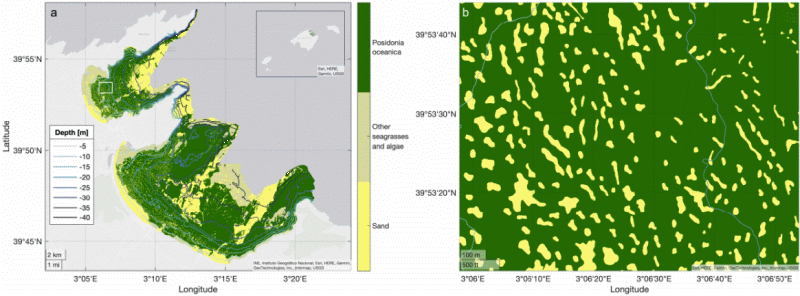R.C. van de Vijsel1,2*, E. Hernández-García1, A. Orfila3, D. Gomila1
1 IFISC (CSIC-UIB). Institute for Cross-Disciplinary Physics and Complex Systems, Palma, Mallorca, Spain; 2 Hydrology and Quantitative Water Management Group, Wageningen University, Wageningen, The Netherlands; 3 IMEDEA (CSIC-UIB). Mediterranean Institute for Advanced Studies, Esporles, Mallorca, Spain
*corresponding author:
Abstract
Spatial patterning, a universal feature of ecosystems worldwide, has recently been recognized as a driver of ecosystem resilience under environmental stress. Understanding pattern formation mechanisms is therefore crucial. Seagrass meadows exhibit a richness of spatial patterns. Spatial self-organization was recently suggested as an explanation for striped and hexagonal patterns in wave-exposed seagrass ecosystems, yet the responsible biogeomorphic interactions have not been clearly identified yet. Here, we show that regular patterning in seagrass meadows can be explained from self-reinforcing feedbacks between wave reflection, bed shear stress and seagrass-induced bedform growth. Field measurements show that seagrass pattern wavelength is approximately half the wavelength of the most energetic forcing waves. We therefore hypothesize that seagrass patterning is driven by Bragg resonance, i.e. maximal reflection of waves travelling over bed undulations with half their wavelength. We derive a full set of coupled equations for wave propagation and the interactions of bed shear stress with seagrass and bedform growth. We then linearize these equations, to study the development of perturbations around the uniform equilibrium state. Numerical simulations of the development of these perturbations show that a uniform seagrass meadow exists for weak wave forcing, but that a modulation instability exists for moderate forcing strength. Beyond this critical threshold, the seagrass meadow develops a pattern with wavelength half that of the incoming wave. Furthermore, the modelled bedforms cause maximal reflection of the forcing wave field. These findings confirm our hypothesis that Bragg reflection can explain meadow self-organization. Future field campaigns should confirm whether seagrass patterning hence provides natural protection of the ecosystem against wave impact. Our findings might apply to other patterned coastal ecosystems as well, and may inspire building-with-nature efforts worldwide in sustainably protecting densely populated coastlines against increasing flood risks.

Figure 1: Seagrass patterns in the Bays of Pollença and Alcúdia (Mallorca, Spain). (a) Overview of the study area. Color shadings indicate different substrate types. Blue lines are isobaths. Inset shows
the area's location within the Balearic Islands. White rectangle indicates the location of map b. (b) Detail of map a, showing spatially regular gap patterns in the seagrass meadow. Bathymetric and substrate data derived from the Life Posidonia project (https://lifeposidonia.caib.es).
I. Surname1*, F.N. Another-Surname2 , Y. Next-Surname2
1 University Name, Country; 2 Organization Name, Country
* Corresponding author: mail.name@organization.org


